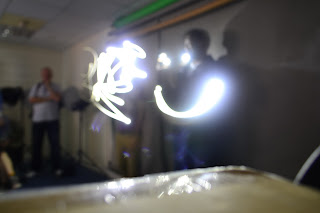What is Aftiicial Light?
Aftificial light is any light that is not sunlight and is man-made.
It has different uses; practical use for lighting rooms or on a lamp or to give an aethentic effect. A good example of this would be the use of ultraviolet light in a night club.
In photography, light has different colour temperatures. Our eyes are constantly adapting to out surrounding 24/7 and occasionally are not able to see the different temperatures and colours or tint of different lights.
A good and noticable example of the different light sources giving temperature is incandescent and fluoresent light.

Incandescent Light - an electrical light which produces light when a filament wire is heated to a high temperature by and electrical current through it until it glows.
Fluorescent Light - a gas-discharge lamp that uses electricity to excite mercury vapor. The excited mercury atoms produce short-wave ultraviolet light that then causes a phosphor to fluoresce, producing visible light.
A fluorescent lamp converts electrical power into useful light more efficiently than an incandescent lamp.























